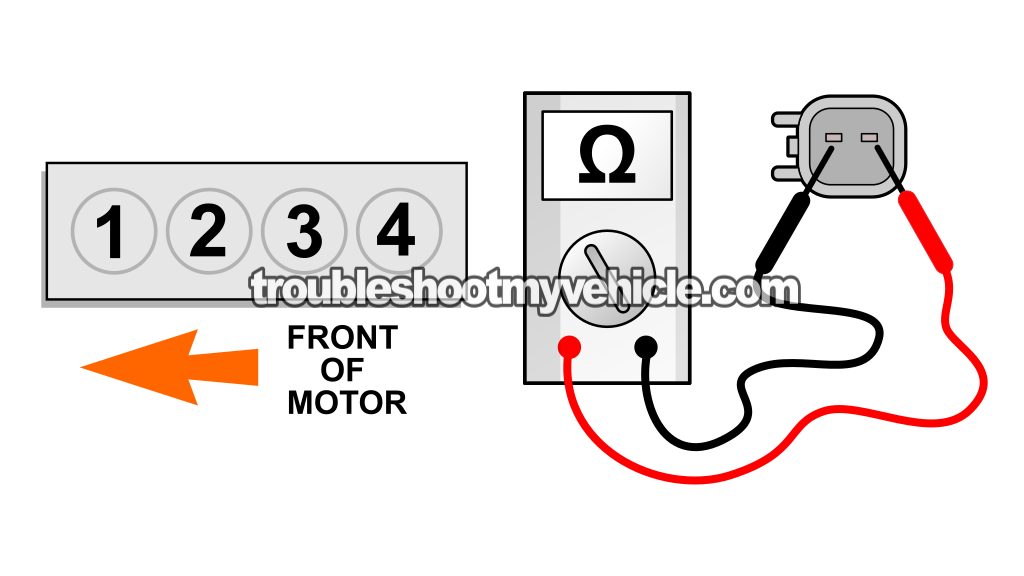
In this tutorial, I'm going to show you how to check the resistance of the fuel injectors with a multimeter to see if they've suffered an internal short or open-circuit problem.
The cool thing about this test is that on the Ford Focus's 2.0L SOHC engine, the injectors are super accessible —no need to remove them to test them.
I'm also going to show you a proven diagnostic strategy you can use to pinpoint a clogged or bad injector —in case you're not sure where to start.
Contents of this tutorial:
APPLIES TO: This tutorial applies to the following vehicles equipped with the single overhead cam (SOHC) engine:
- 2.0L SOHC Ford Focus: 2000, 2001, 2002, 2003, 2004.
2000-2004 DOHC FUEL INJECTOR TESTS:
Symptoms Of A Bad Fuel Injector
It's been my experience over the years, diagnosing all kinds of fuel injector problems, that they'll usually fail in one of three ways.
- Failure 1: The injector fails internally and stops spraying fuel.
- Failure 2: The injector clogs up, restricting its fuel flow or spray pattern.
- Failure 3: The injector doesn't activate due to missing power or switching (activation) signal.
Since the fuel an injector sprays is critical to keep its cylinder running right, if it fails or doesn't inject enough, you'll notice one or more of the following engine performance issues:
- Rough idle.
- Lack of power.
- Hesitation when you step on the gas pedal to move the vehicle down the road.
- Misfire diagnostic trouble code (DTC):
- P0300: Random Cylinder Misfire.
- P0301: Cylinder #1 Misfire.
- P0302: Cylinder #2 Misfire.
- P0303: Cylinder #3 Misfire.
- P0304: Cylinder #4 Misfire.
Although the focus of this tutorial is checking each of the four injector coils to see if they've suffered an electrical issue that prevents them from injecting fuel, I can tell you from personal experience that testing for a clogged injector isn't much harder. I'll also be covering how to do that in this guide.
Checking The Injector's Internal Resistance

Each fuel injector on your Focus is built around an internal coil winding. Over time, this coil will fail —either it suffers an open-circuit or a short-circuit issue.
The good news is you don't need anything fancy to check it —just a multimeter. If the injector's coil is OK, its resistance should fall between 13.8 and 15.2 Ohms.
If the internal winding has failed, the multimeter will either show 0 Ohms (short-circuit) or infinite resistance (open-circuit). Any reading outside 13.8–15.2 Ohms means that injector is toast.
NOTE: Don't have a multimeter or need to upgrade yours? Check out my recommendation: Tekpower TP8268 AC/DC Auto/Manual Range Digital Multimeter (Amazon affiliate link).
Alright, here are the steps:
- 1
Disconnect the fuel injectors from their harness connectors.
NOTE: The illustration above will help you identify the cylinder # the fuel injector belongs to. - 2
Place your multimeter in Ohms (Ω) mode.
- 3
Measure the resistance of the fuel injector across its two male spade terminals with the multimeter test leads (see the illustration above).
SPECIFICATION: The fuel injector resistance specification is: 13.8-15.2 Ohms. - 4
Write down the resistance value that your multimeter records for the specific fuel injector you're testing.
The illustration above will help you identify the cylinder # the fuel injector belongs to. - 5
Check the resistance of the remaining fuel injectors.
Let's find out what your specific multimeter test results mean:
CASE 1: The resistance of all four fuel injectors is within the indicated specification. Awesome. This is the correct and expected test result, and it confirms that none of them have suffered an internal electrical failure.
Although the fuel injector is OK electrically inside, there's still a good chance that it could be clogged and causing a rough idle condition or a cylinder misfire. To troubleshoot this further, head over to: How To Find The Bad Or Clogged Fuel Injector.
CASE 2: You found a fuel injector with a different resistance value, not within spec. This test result tells you that that fuel injector is bad and needs to be replaced.
How To Find The Bad Or Clogged Fuel Injector
It can be a challenge to pinpoint a clogged or bad fuel injector, but I want to assure you that there is a step-by-step logical process that you can take to pinpoint the bad or clogged fuel injector.
In this section, I'm going to share the method that I've used for years that'll help you identify the exact cause of the cylinder misfire you're trying to diagnose.
-
Step 1 —Identify the "dead" cylinder by checking for misfire codes (P0301–P0304) or performing a cylinder balance test.
This is the most important first step in the whole process. You can mix and match the following steps, but only after identifying the dead cylinder.
-
Step 2 —Confirm the "dead" cylinder is getting spark using a dedicated spark tester.
During the spark check, we also need to:
- See if the spark plug boot and spark plug are soaked in engine oil.
- Remove and inspect the spark plugs for cracks or carbon tracks, which can cause misfires.
NOTE: If you find any of these problems with the spark plug or its boot, you'll need to replace them, since they're definite causes of a cylinder misfire.
The goal of the spark tests is to rule out the coil pack, spark plug wire, and spark plug as the source of the "dead" cylinder's misfire.
This tutorial will help you test the coil pack and spark plug wires:
The following case study is a good example of how carbon tracks —caused by oil leaking from the valve cover— can lead to a cylinder misfire:
- Carbon Tracks Are A Common Cause Of Ignition Misfires (at: easyautodiagnostics.com).
-
Step 3 —Check the "dead" cylinder's compression to rule out mechanical issues.
If the cylinder is suffering some sort of internal mechanical problem, it's not going to be able to compress the air-fuel mixture, and it will either cause a rough idle condition or a cylinder misfire.
In the following guide, you can find detailed instructions on how to perform the compression test and also, just as important, how to interpret its results:
-
Step 4 —Perform a fuel injector Noid light test if spark and compression check out.
The purpose of the Noid Light test is to make sure that the "dead" cylinder's fuel injector is receiving both power and an activation signal.
The following tutorial explains how this test is done and it will also show you where you can buy a Noid Light kit:
- How To Use A Noid Light And Where To Buy It (at: easyautodiagnostics.com).
-
Step 5 —Swap the suspect injector with its neighbor only after ruling out ignition issues, confirming good compression, and verifying the injector's internal resistance.
The idea behind swapping the "dead" cylinder's fuel injector with its neighbor is to see if the misfire follows the swapped injector.
If the misfire now moves to that cylinder where you put the injector in, then now you know that injector is either clogged or bad and either needs to be cleaned or replaced.
Troubleshooting the exact cause of a cylinder misfire can be quite the challenge, but it's not impossible. It's something you can do with a little patience and a solid diagnostic strategy.
The most important thing that you need to keep in mind is that you have to begin by first identifying the dead cylinder. This important first step is going to save you a lot of time, money, and frustration.
If you follow the test steps I've outlined above, I'm certain it will help you pinpoint the issue, whether it's a bad or clogged fuel injector or something else, without the frustration of spending money on parts that won't solve the issue.
More 2.0L Ford Focus Diagnostic Tutorials
You can find a complete list of 2.0L Ford Focus tutorials in this index:
Here's a small sample of the tutorials you'll find in the index:
- How To Test The MAF Sensor (2000-2004 2.0L Ford Focus).
- How To Test The Throttle Position Sensor (2000-2004 2.0L SOHC Ford Focus).
- How To Test For A Blown Head Gasket (2000-2010 2.0L Ford Focus).
- How To Test The Ignition Coil Pack (2000-2004 2.0L Ford Focus).

If this info saved the day, buy me a beer!

